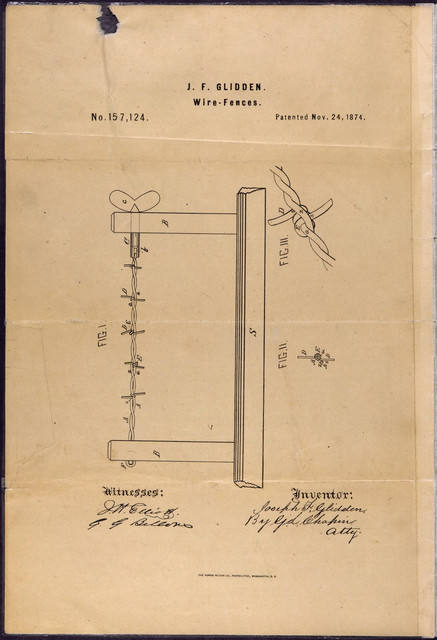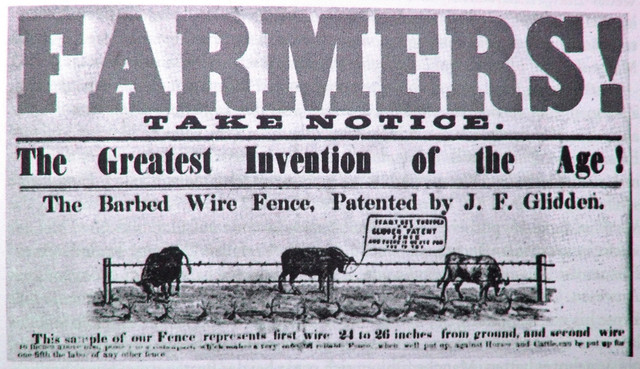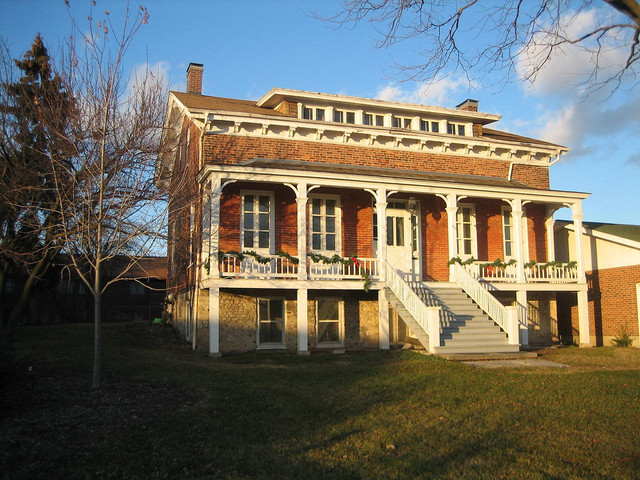Martin Antonenko
A Fixture
- Joined
- Jul 11, 2008
- Messages
- 8,994
"The Greatest Invention of the Age!"
Hardly anyone knows the name Joseph Glidden today!

And yet this man, an American farmer from the dump of DeKalb (Illinois, USA), made an invention that contemporaries - if not without exaggeration - described as the "greatest innovation of the century".
Farmer Gidden, who ran his agriculture in an area in which cattle breeding dominated, had often been annoyed that on large cattle drives the herds guarded by only a few cowboys simply trampled his harvests on the march and thus destroyed ...:

So he sat down, pondered a device to protect his fields - and invented the barbed wire!

On November 24, 1874 he received the patent for his invention - here is a page from the patent specification ...:

Gliddens' invention hit agriculture like a bomb, and cattle farmers were soon convinced of the value of barbed wire.
Gliddens initially founded the "Barb Fence Company" based on his patent ...

... but sold them - including half of his patent rights for $ 60,000 and license fees - to the "Washburn & Moen Manufacturing Company" and preferred to become a sheriff in his home town.



When the military saw the value of barbed wire as an obstacle on the battlefield, sales literally went through the roof - and Gliddens became one of the richest men in America.
War without barbed wire - that was no longer imaginable after the Russian-Japanese war at the latest and reached its climax in World War I, during which initially simple barbed wire obstacles in front of the trenches ...

... were gradually expanded to almost impenetrable wire jungles ...:


During the Second World War, the need for barbed wire was also enormous ...:

And with every roll of wire produced, Gliddens' heirs also earned! He himself died on October 9, 1906 ...:

However, Gliddens' invention has been in steady decline since the late 1960s, since - again in the USA - an even meaner obstacle wire was invented:
Instead of coiled spikes, it has thousands of built-in razor-sharp blades - and you can't just attack it with wire cutters, because it is much harder than the original barbed wire and also does not rust - like this one - because it is hot-dip galvanized ... :

At the beginning of the 1970s, the new wire from the USA was first introduced to NATO troops in Europe, which is why we know it under the name "NATO S-wire", while in the most beautiful German bureaucratic jargon it is actually called "Widerhakensperrdraht" ....
This wire is also used in a wide variety of ways today - Hungary laid plenty of the stuff outside its borders to keep unwanted refugees away ...:

However, the house of Joseph Glidden in DeKalb, who was called "The King of Barb Wire" during his lifetime in the USA, is owned by his family until today...

... and of course has a "barbed wire memory corner" ...:

Hardly anyone knows the name Joseph Glidden today!

And yet this man, an American farmer from the dump of DeKalb (Illinois, USA), made an invention that contemporaries - if not without exaggeration - described as the "greatest innovation of the century".
Farmer Gidden, who ran his agriculture in an area in which cattle breeding dominated, had often been annoyed that on large cattle drives the herds guarded by only a few cowboys simply trampled his harvests on the march and thus destroyed ...:

So he sat down, pondered a device to protect his fields - and invented the barbed wire!

On November 24, 1874 he received the patent for his invention - here is a page from the patent specification ...:

Gliddens' invention hit agriculture like a bomb, and cattle farmers were soon convinced of the value of barbed wire.
Gliddens initially founded the "Barb Fence Company" based on his patent ...

... but sold them - including half of his patent rights for $ 60,000 and license fees - to the "Washburn & Moen Manufacturing Company" and preferred to become a sheriff in his home town.



When the military saw the value of barbed wire as an obstacle on the battlefield, sales literally went through the roof - and Gliddens became one of the richest men in America.
War without barbed wire - that was no longer imaginable after the Russian-Japanese war at the latest and reached its climax in World War I, during which initially simple barbed wire obstacles in front of the trenches ...

... were gradually expanded to almost impenetrable wire jungles ...:


During the Second World War, the need for barbed wire was also enormous ...:

And with every roll of wire produced, Gliddens' heirs also earned! He himself died on October 9, 1906 ...:

However, Gliddens' invention has been in steady decline since the late 1960s, since - again in the USA - an even meaner obstacle wire was invented:
Instead of coiled spikes, it has thousands of built-in razor-sharp blades - and you can't just attack it with wire cutters, because it is much harder than the original barbed wire and also does not rust - like this one - because it is hot-dip galvanized ... :

At the beginning of the 1970s, the new wire from the USA was first introduced to NATO troops in Europe, which is why we know it under the name "NATO S-wire", while in the most beautiful German bureaucratic jargon it is actually called "Widerhakensperrdraht" ....
This wire is also used in a wide variety of ways today - Hungary laid plenty of the stuff outside its borders to keep unwanted refugees away ...:

However, the house of Joseph Glidden in DeKalb, who was called "The King of Barb Wire" during his lifetime in the USA, is owned by his family until today...

... and of course has a "barbed wire memory corner" ...:





